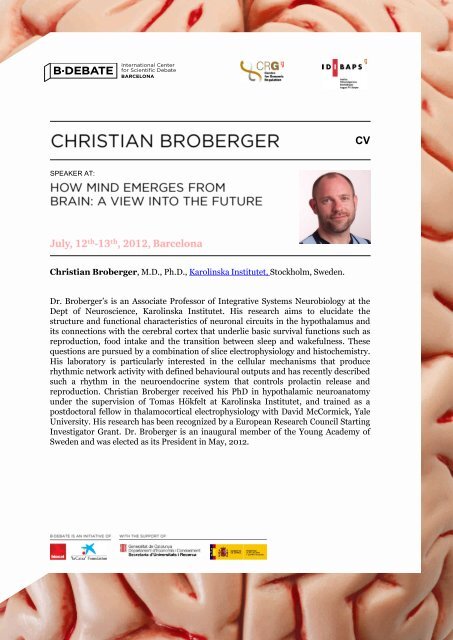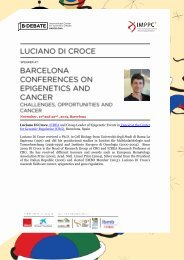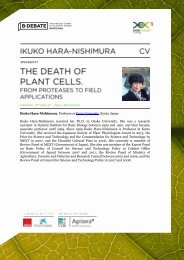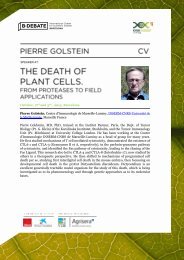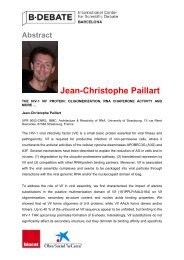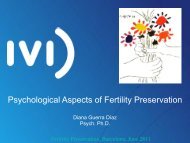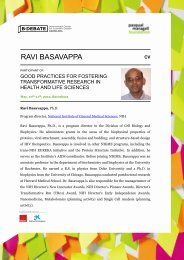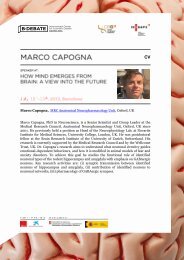CV and abstract Christian Broberger - B·Debate
CV and abstract Christian Broberger - B·Debate
CV and abstract Christian Broberger - B·Debate
- No tags were found...
Create successful ePaper yourself
Turn your PDF publications into a flip-book with our unique Google optimized e-Paper software.
<strong>CV</strong>SPEAKER AT:<strong>Christian</strong> <strong>Broberger</strong>, M.D., Ph.D., Karolinska Institutet, Stockholm, Sweden.Dr. <strong>Broberger</strong>’s is an Associate Professor of Integrative Systems Neurobiology at theDept of Neuroscience, Karolinska Institutet. His research aims to elucidate thestructure <strong>and</strong> functional characteristics of neuronal circuits in the hypothalamus <strong>and</strong>its connections with the cerebral cortex that underlie basic survival functions such asreproduction, food intake <strong>and</strong> the transition between sleep <strong>and</strong> wakefulness. Thesequestions are pursued by a combination of slice electrophysiology <strong>and</strong> histochemistry.His laboratory is particularly interested in the cellular mechanisms that producerhythmic network activity with defined behavioural outputs <strong>and</strong> has recently describedsuch a rhythm in the neuroendocrine system that controls prolactin release <strong>and</strong>reproduction. <strong>Christian</strong> <strong>Broberger</strong> received his PhD in hypothalamic neuroanatomyunder the supervision of Tomas Hökfelt at Karolinska Institutet, <strong>and</strong> trained as apostdoctoral fellow in thalamocortical electrophysiology with David McCormick, YaleUniversity. His research has been recognized by a European Research Council StartingInvestigator Grant. Dr. <strong>Broberger</strong> is an inaugural member of the Young Academy ofSweden <strong>and</strong> was elected as its President in May, 2012.
ABSTRACTSPEAKER AT:Hypothalamic Circuit Interactions: Ready for Prime Time?<strong>Christian</strong> <strong>Broberger</strong>, M.D., Ph.D., Karolinska Institutet, Stockholm, Sweden.Harvey Cushing described the hypothalamus as “the mainspring of primitive existence …on which, with more or less success, man … has come to super-impose a cortex ofinhibitions”. Minute lesions to specific parts of this collection of nuclei cause dramaticchanges in phenotype: voracious eating, uninhibited sexual behavior <strong>and</strong> rage to name afew. Yet, despite its vital role in keeping us alive, well <strong>and</strong> reproducing, our underst<strong>and</strong>ingof the network interactions that produces hypothalamic output is still relatively primitive.Indeed, we have amassed a large catalogue of observations on the connectivity, transmitterexpression, cytoarchitectonics etc. of neurons. But in comparison with many other brainregions, such as the cerebral cortex <strong>and</strong> thalamus, we know relatively little about howelectrical properties <strong>and</strong> synaptic connections combine to produce network interactions inthe form of e.g. oscillations. Technical advances are now overcoming limitations in theform of cellular heterogeneity <strong>and</strong> limited anatomical accessibility of the hypothalamus,which have hampered out underst<strong>and</strong>ing. In our work, we have focused ontuberoinfundibular dopamine (TIDA) neurons, a neuroendocrine population that providestonic inhibition of pituitary prolactin release, constraining lactation to the nursing periodin the post-partum mother. In TIDA neurons, we have identified a robust 0.05 Hzoscillation, synchronized across the population through gap junctions. We propose thatchanges in discharge pattern, from e.g. phasic to tonic firing, serve to adjust dopamineoutput <strong>and</strong>, in turn, prolactin secretion, in tuning reproductive state. The role of individualconductances responsible for cellular <strong>and</strong> network behavior is now being dissected toprovide insight into the regulation of lactation in particular <strong>and</strong> neuroendocrine control ingeneral.


